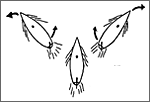Mooring lines
Does your boat sit at a mooring buoy all week while you are at work? While the boat is untended, and subject to the vagaries of wind and tide, chafe may be working on your buoy line. Eventually, usual
Does your boat sit at a mooring buoy all week while you are at work? While the boat is untended, and subject to the vagaries of wind and tide, chafe may be working on your buoy line. Eventually, usually at the height of a storm the line will part and your boat could be driven ashore. Or worse yet it might get holed and sink, leaving you to recover it.
To reduce chafe, first look over the area near the bow chocks. Check that the chock has no sharp edges. If it does you should file or grind them smooth (or fit another chock). Quite often the chock is set a little inboard and the line must run over the edge of the deck. While this angle looks like a smooth fiberglass corner it can, if it is reasonably acute, eventually cut your mooring line. Also check the stem. Is your stainless steel headstay fitting bolted down the front of the stem. If it is, can the anchor rode catch or chafe on the stainless?
If you lead the mooring line over a bow roller, check to see if the line can be chafed by the sides of the roller. Quite often bow rollers are fabricated from welded stainless steel and the angles and edges are quite sharp. If the pull on your bow line is not square over the roller, chafe can easily occur.
If you have found several fairly sharp edges that cannot be eliminated you might want to install some protection on your mooring line. Purchase from your local marine store a length of clear heavy-duty tubing - about three feet is usually long enough. The tubing is made by Perimeter Industries and can be supplied at any length. (Davis Marine also has Secure: Removable Chafe Guards.) Make sure your mooring line can pass easily through the middle of it. Then make two small holes (about 1/8 inch diameter.) at each end. Through these holes pass about one-foot of 1/8-inch line and secure it tightly. Now put the tubing on the mooring line, making sure they cover the line where it passes over cleats, the edge of the deck, and other potential trouble spots. Using a marlin spike open the lay of the anchor or mooring rode and thread the 1/8 inch line through it. Do this at both ends of the tube and secure it tightly so that it cannot move along the anchor rode.
The tubing can be replaced at any time during the season and should be checked regularly to ensure that it is not getting abraded and cut by fixtures in the bow area. If it is, replace it.












